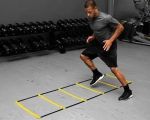Maximizing Your Gym Experience: A Path to Achieving Your Fitness Goals
Achieving fitness goals isn't just about working out; it’s about building a sustainable routine, finding motivation, and understanding how to properly use the gym to reach your full potential. Whether you’re aiming for weight loss, muscle gain, or improving overall health, the gym offers a wide range of tools to support you. In this article, I’ll share how to get the most out of your gym experience, with tips and strategies that have helped me and many others succeed in their fitness journeys.
1. Understanding Your Fitness Goals
Before stepping into the gym, it's crucial to define your fitness goals clearly. Are you aiming to lose weight, build muscle, improve endurance, or just stay healthy? Your goals will determine the types of exercises you should focus on. For instance, if you're trying to lose weight, incorporating cardio exercises and strength training will help you burn fat and increase metabolism. If muscle gain is your goal, strength training with progressive overload is key.
Having a clear goal also allows you to measure your progress and adjust your workouts as needed. For me, I started out focusing on weight loss but gradually shifted to muscle building. Understanding my body’s response to different workouts and nutrition helped me achieve my fitness milestones more effectively.
2. Creating a Personalized Gym Workout Routine
Once you have defined your fitness goal, it’s time to create a personalized workout routine. The key to success in the gym is consistency, but also smart planning. A one-size-fits-all approach doesn’t work for everyone, so customizing your routine according to your needs is essential.
For beginners, a full-body workout is a great starting point, focusing on major muscle groups and building a foundation of strength. As you progress, you can split your workouts into specific muscle groups (like chest, back, legs) to maximize muscle development. Don’t forget to include flexibility and mobility exercises to prevent injury and improve your overall movement.
3. Focusing on Proper Form and Technique
When I first started working out at the gym, I made the mistake of rushing through exercises without paying attention to proper form. This not only limited my progress but also increased my risk of injury. Learning the right technique for every exercise is fundamental to achieving results and staying safe.
If you’re unsure about your form, don’t hesitate to ask a trainer or experienced gym-goer for help. Many gyms also offer beginner classes or personal training sessions that can teach you the basics of strength training and cardio exercises. Once you master the proper form, you’ll be able to target the right muscles more effectively and avoid unnecessary injuries.
4. Tracking Your Progress
One of the best ways to stay motivated and keep improving is by tracking your progress. I recommend keeping a fitness journal or using an app to record your workouts, weights, reps, and how you feel during each session. This will help you see how far you’ve come and keep you motivated when things seem tough.
Tracking progress isn’t just about numbers; it’s about how your body feels and how your energy levels improve. Over time, you’ll notice that your endurance improves, and the weights you lift get heavier, reflecting the hard work you’ve put in.
5. The Importance of Rest and Recovery
When I was first starting out, I used to think that more workouts meant faster results. However, overtraining can lead to burnout and injury. Rest is just as important as the workouts themselves. Your muscles need time to repair and grow stronger, so make sure to schedule rest days in your routine. Proper sleep, hydration, and nutrition also play a significant role in your recovery process.
Remember, it's not about pushing yourself to the max every time. A balanced approach, with both challenging workouts and proper recovery, will help you progress steadily toward your fitness goals.
6. Staying Motivated and Overcoming Challenges
Motivation can be hard to maintain, especially when you’re not seeing immediate results. It’s important to remind yourself that fitness is a long-term journey. I’ve had days when I felt like giving up, but finding small victories kept me going. Whether it’s lifting a heavier weight, running an extra mile, or simply showing up for your workout, celebrate the little achievements.
One strategy that helped me was setting short-term goals that were achievable but still challenging. For example, if I was aiming to run 5 miles, I’d break it down into smaller goals—starting with 2 miles, then 3, and so on. Achieving those incremental goals kept me motivated and on track.
7. Nutrition: Fueling Your Fitness Journey
Fitness and nutrition go hand in hand. What you eat directly impacts your performance in the gym and your progress toward your goals. I’ve learned that a well-balanced diet, rich in protein, healthy fats, and complex carbohydrates, is crucial for building muscle and losing fat. Make sure to adjust your calorie intake based on your goals—whether you’re in a calorie deficit for weight loss or a calorie surplus for muscle gain.
If you’re unsure about your nutrition, consider consulting with a dietitian or a fitness expert who can guide you in creating a meal plan tailored to your needs. Healthy eating is not about restriction; it's about nourishing your body to perform its best.
8. Making the Most of Gym Equipment
Gyms offer a variety of equipment designed to help you reach your fitness goals, from free weights to resistance machines, and cardio equipment like treadmills and bikes. However, using the equipment properly is key to making the most of your gym time.
For example, free weights like dumbbells and barbells are fantastic for building strength and muscle mass, but they require good technique and proper progression. Machines, on the other hand, can help isolate specific muscles and offer a safer option for beginners learning the ropes of weight training. Incorporating both into your routine can give you a balanced workout and prevent plateaus.
9. Finding the Right Gym Community
The gym environment can make a big difference in your fitness journey. When I first started, I found it intimidating, but over time I realized how much the gym community can motivate you. Surrounding yourself with like-minded individuals can help you stay focused and inspired. Don’t hesitate to join group classes or engage with others who have similar fitness goals.
Whether it’s the energy from a high-intensity class or the friendly competition during your workout, being part of a gym community can push you to do better. If your gym offers group training or fitness challenges, consider participating—it can bring a new level of excitement and support to your routine.
10. Never Stop Learning and Evolving
Finally, one of the most important things I’ve learned in my fitness journey is that you should never stop learning. The fitness industry constantly evolves with new techniques, trends, and research. What works for you today may not work tomorrow, so stay open-minded and willing to adapt. Whether it’s learning about new workout methods, nutrition strategies, or recovery techniques, staying informed will help you keep improving.
As you grow stronger, more knowledgeable, and more confident, the gym will no longer just be a place to workout—it will become a second home, a place where you constantly strive to be better, healthier, and stronger.








